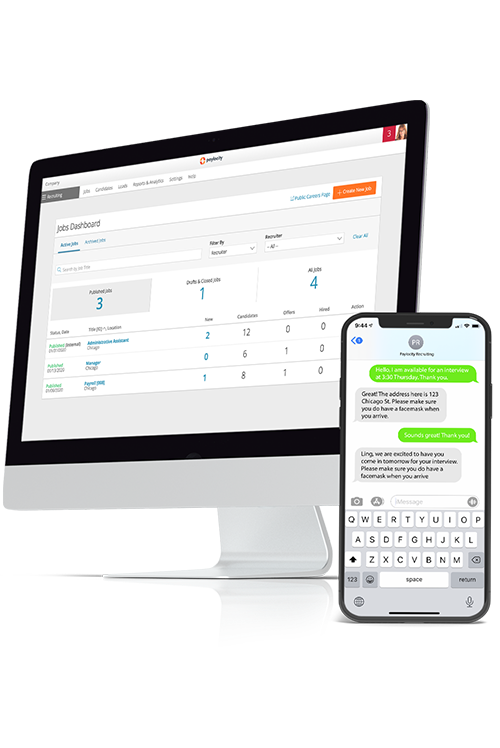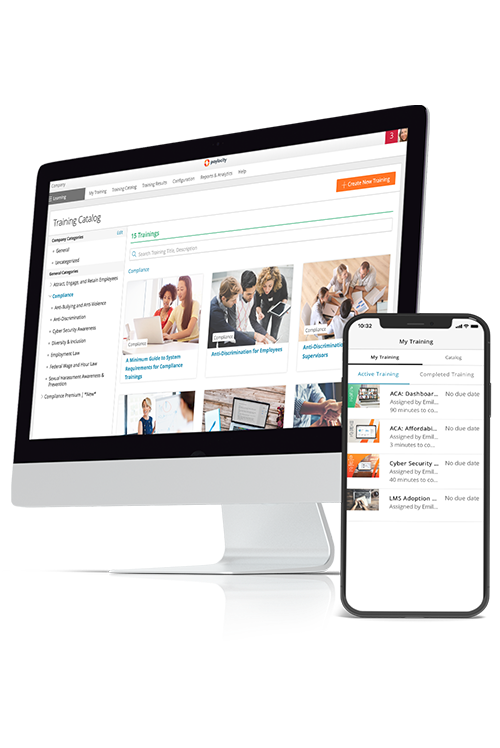
How Manufacturers Can Overcome Top HR Challenges in 2024
An updated employee experience helps create a people-first, technology-forward employer brand that stands out.
Today’s manufacturing operations are smart, lean, and sustainable. As early adopters of transformative technologies like robotics, 3D printing, and the Internet of Things, manufacturers lead the Industry 4.0 charge.
Still, there’s a lingering perception that manufacturing jobs are dull, dirty, and dangerous. Where’s the disconnect?
If your recruitment process is disjointed or bogged down in paperwork, you’re already starting at a disadvantage in a challenging labor market. Missed communications or a glitchy app can send applicants running — to your competitors.
Manufacturers also must compete to hold onto their top talent. While many have installed cutting-edge tech in the factory, they put legacy HR tools in their employees’ hands.
Providing an engaging, modern employee experience can help manufacturers differentiate their employer brand to improve both recruitment and retention. Let’s look at how.
Challenge #1: How Can Manufacturing Address the Skilled Labor Shortage?
The skills gap in manufacturing is not new, but the fast pace of innovation may be widening it.
In the U.S., Deloitte and The Manufacturing Institute estimate as many as 2.1 million manufacturing jobs will go unfilled by 2030. As Baby Boomers retire and technology advances, HR leaders must recruit and retain workers who can (and want to) grow with the company.
Increasingly, entry and mid-level jobs require a combination of technology skills, specialized skills, and "soft" skills like problem solving and adaptability. Nearly two-thirds of manufacturers say they struggle to fill job vacancies because skill requirements change rapidly.
Solution: Level Up In-House Training with a Learning Platform
Manufacturers can bridge skills gaps by offering personalized, self-paced learning and comprehensive career development opportunities.
A learning management system (LMS) provides the backbone for an internal training program. Typically, this software lets you automatically assign courses and track progress, which is great for organizations that have mandatory training.
A unified HCM platform facilitates broader development for employees across the lifecycle, from self-paced training to goal setting to career pathing. Built-in learning and performance management systems empower employees to pursue the opportunities most relevant to them, which not only helps bridge knowledge gaps but also increases retention.
To level up workforce development, manufacturers can look for these features:
- 24/7 mobile access makes it easier for employees to complete trainings, quickly view assigned courses, and search your catalog for on-demand learning opportunities.
- A robust course catalog provides both required safety training and courses to improve career skills like leadership and communication.
- In-platform content creation preserves industry knowledge with tools to record screen shares, design quizzes, and import web-ready coursework.
- Artificial Intelligence (AI) surfaces recommended courses based on job title, function, or career goals.
- Journals and other feedback tools drive goal and career development conversations between employees and supervisors.
Related: Using Skills Gap Analysis to Develop Your Employees
Challenge #2: How Can Manufacturing Make a Better First Impression?
Many manufacturers work hard to build an attractive employee experience that provides the rewards today’s workers are looking for — competitive wages, advancement, and a values-based culture.
Without a seamless recruitment and onboarding process, you may be giving new hires the wrong first impression.
Early-career manufacturing candidates expect employers to meet them where they are, with the technology they use every day. That takes more than an applicant tracking system and a boilerplate welcome email.
Solution: Streamline and Personalize the Candidate Experience
When a new hire’s first experiences with your company are frictionless and friendly, you’ve already laid the groundwork for ongoing success.
Next-generation recruitment software combines automation, integrated background checks, templates, reporting, and analytics to save time and keep the hiring process running smoothly. It also enables employers to personalize the recruitment experience, with advanced capabilities like:
- Text-to-apply and scan-to-apply promotions.
- Generative AI to compose compelling job descriptions.
- Friendly just-in-time reminders about interviews and form submissions.
Once a new hire signs their offer letter, the preboarding period (until their official start date) is a great opportunity to connect employees with your company and the services you provide. It’s also a chance to make new hires feel welcome and connected to their peers.
With consumer-grade mobile tools, preboarding activities are easier for both employees and HR. And again, more personal. For example:
- A wizard-driven app walks employees step-by-step through completing Form I-9 and setting up direct deposit.
- The CEO sends a video greeting via email or text.
- Employees receive regular communications that prepare them for day one, including instructions about where to park, dress code, security procedures, etc.
- A survey collects employee skills and certifications information.
Pro Tip:
During orientation, make sure employees have downloaded your HR mobile app and spend time exploring the tools together. Show them how to look up their schedule and check their paystub, and where to find answers or reach out for additional help.
Starting a new job is stressful. Providing a smooth transition between recruitment and onboarding helps employees start excited to join your company and confident they’ve made the right decision.
Challenge #3: How Can Manufacturing Help Employees Feel Connected?
In a survey of 600 factory workers, respondents named five top factors they would look for in a new employer:
- More paid time off
- Flexible work schedule
- Management who listens
- Non-monetary perks
- Better tools and technology
While a modern HCM solution can’t grant vacation time or put snacks in the breakroom, it can provide employees more autonomy to manage their work-life balance. It also helps you create a culture of recognition.
Solution: Flexibility and Feedback Fuel Employee Engagement
Today, technology makes it easier to place your workforce’s needs and expectations at the heart of your employee experience strategy.
For example, an employee self-service portal and on-demand payment options offer greater flexibility, putting company information and same-day funds at workers’ fingertips with no added burden to HR or finance.
At the same time, the new wave of employee feedback technology helps employees feel heard and valued. Proactive listening tools, like Paylocity’s Employee Voice, go beyond the traditional annual survey to provide AI-powered insights that help management prioritize engagement efforts and monitor progress over time.
The High ROI of Recognition
Recognition and rewards programs elevate moments that matter, showcasing your values in action and boosting morale. But just as important, more than a third of employees say more personal recognition would encourage them to produce better work more often.
When recognition and rewards technology is embedded in an all-in-one HCM platform, everyone benefits:
- Employees find it easy to give and receive recognition through the same app they use to punch in or check their pay.
- Managers are reminded of employee milestones like birthdays and anniversaries. At review time, managers can see employees’ recognition history.
- HR administrators can manage rewards using intuitive budgeting tools and built-in taxation.
The Future of Manufacturing Is on the Line
Just as industrial technology powers innovation in manufacturing, HR technology can fuel growth. To attract and retain a workforce that will thrive tomorrow, manufacturers must demonstrate that their employee experience is as state-of-the-art as their products.
A comprehensive HCM solution, like Paylocity’s cloud-based platform, not only streamlines core functions like payroll and benefits administration. It empowers employees with tools that keep them connected and engaged, no matter when, where, or how they work.
See how Paylocity’s software suite is custom-built to meet the HR and payroll needs of manufacturers — now and in the future.





?$Hero-Card$)